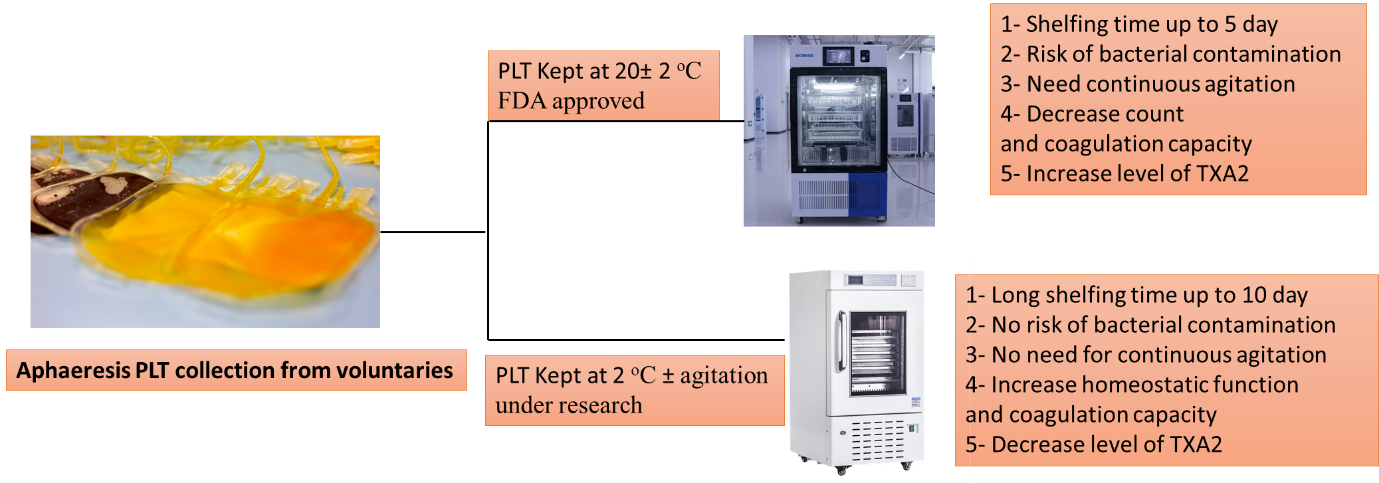Biochemical characteristics and functional performance of cold-stored platelets: an in-vitro comparative study
DOI:
https://doi.org/10.31989/bchd.v6i6.1084Abstract
Background: Platelet refrigeration could eliminate bacterial contamination and improve the hemostatic function even better than already-used room-temperature storage. This study aimed to assess the effect of cold storage, with and without agitation, on the apheresis platelets' hemostatic, metabolic, and functional activity.
Materials and methods: The study included 10 healthy volunteer donors to collect Apheresis PLT. They were submitted to careful clinical examination and standard laboratory workup. Collected samples were processed in accordance with American Association of Blood Banks (AABB) guidelines. Every aliquot collected from each volunteer was stored for up to 5 days at one of the following storage conditions: 1. In an FDA-approved-PLT incubator with agitation at room temperature (RT + AG as a group; GI), 2. In an FDA-approved-refrigerator at 4 oC with agitation (4 oC + AG as a group; GII), 3. In an FDA-approved- refrigerator at 4 oC without agitation (4 oC – AG as a group; GIII). The following PLT workup was done; PLT count and mean platelet volume (MPV), metabolic variables, PLT aggregation studies, PLT receptors expression, and PLT pro-inflammatory mediator’s release.
Results:All samples had a significant PLT count decline compared to baseline data. No changes in MPV were observed in all groups on day 3 and day 5, meaning that single PLT size remained unchanged. In addition, GI showed a mark of significant increase in metabolic activity when compared to baseline PLTs in contrast to GII, and GIII, which were more metabolically stable and less active.
Comparison between the studied groups regarding PLT aggregation revealed significantly higher PLT aggregation response to ADP and collagen in GII and GIII compared to GI on the 3rd and 5th days. Moreover, it was shown that GII and GIII samples had significantly higher CD62p expression when compared with GI on the 3rd and 5th days despite being less active and more stable. While it was found that TXB2 levels were significantly higher, nearly 3-fold, in GI as compared to GII and GIII.
Conclusions: Apheresis platelets (AP) cold storage provides a clear advantage over standard conditions regarding biochemical balance and hemostatic performance, which could markedly improve AP's clinical and economic value in different scenarios.

Keywords: Platelet aggregation, P-selectin, Thromboxane B2.
Downloads
Published
Issue
Section
License
Copyright (c) 2023 FFC/Bioactive Compounds in Health and Disease

This work is licensed under a Creative Commons Attribution-NonCommercial 4.0 International License.
Any manuscripts or substantial parts of it, submitted to the journal must not be under consideration by or previously published in any other journal or citable form. Authors are required to ensure that no material submitted as part of a manuscript infringes existing copyrights or the rights of a third party. In submitting one's article in any form, the author has assigned the FFC publishing rights and has agreed to an automatic transfer of the copyright to the publisher. This is so that the FFC may create print option journals, for example, at the FFC’s discretion. If the author wishes to distribute their works by means outside of the FFC, for example within their community, they will have to place a request.
Correspondence concerning articles published in Functional Foods in Health and Disease is encouraged. While derivative works (adaptations, extensions on the current work, etc.) are allowed, distribution of the modified material is not allowed without permission from the FFC.